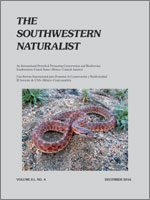The American beaver (Castor canadensis) has been promoted as a tool for restoring aquatic and riparian ecosystems in Western North America. However, little is known about the ecology of beavers in arid environments. The purpose of this study was to examine selection of habitat and woody forage species during winter along the Rio Grande in southern New Mexico. We compared habitat characteristics at sites where beavers were present and absent and evaluated forage selection of woody plants at presence sites. Beavers occurred at sites that retained water over winter and that had larger pools, higher cover of sedges (Cyperaceae), higher abundance of narrowleaf willow (Salix exigua) stems, and higher diversity of woody stems. For foraging, beavers strongly selected Rio Grande cottonwood (Populus deltoides) and Russian olive (Elaeagnus angustifolia) and used willows slightly more than available proportionately. We concluded that, while cottonwoods might require protection from beaver foraging, beavers were not having a negative impact on willows and did not promote saltcedars via ecological release.
How to translate text using browser tools
1 December 2016
Habitat and forage selection by the American beaver (Castor canadensis) on a regulated river in the Chihuahuan Desert
Isidro A. Barela,
Jennifer K. Frey
ACCESS THE FULL ARTICLE

The Southwestern Naturalist
Vol. 61 • No. 4
December 2016
Vol. 61 • No. 4
December 2016




